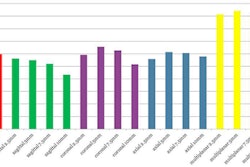SAN FRANCISCO - New clinical guidelines released this week support the use of CT to screen high-risk individuals for lung cancer. But while the guidelines are the next step toward large-scale screening, they advise the scans only for individuals ages 55 to 74 who have more than 30 pack-years of smoking history.
Published online May 20 in the Journal of the American Medical Association, and presented the same day at the 2012 American Thoracic Society meeting in San Francisco, the guidelines represent the work of an analysis by the American College of Chest Physicians (ACCP) and other medical societies. The study is the first to comprehensively evaluate the benefits and potential harms of lung cancer screening in light of the National Lung Screening Trial (NLST) results that showed 20% mortality reduction from CT screening.
As encouraging as the 2010 NLST results were, they left plenty of questions unanswered about who, precisely, should be screened with CT, and what potential benefits and harms they might expect from it. The authors of the JAMA study attempted to answer these questions in their current analysis.
People with the longest history of smoking -- more than 30 pack-years, or a pack a day for more than 30 years -- are the most likely to benefit from CT screening and, therefore, are the only group for whom screening can be recommended without further study, concluded Dr. Peter Bach from Memorial Sloan-Kettering Cancer Center in New York City and colleagues (JAMA, May 20, 2012).
The review, a multisociety collaborative effort that underpins the new clinical practice guidelines from the American College of Chest Physicians and the American Society of Clinical Oncology, looked at eight randomized, controlled trials and 13 cohort studies of low-dose lung cancer screening.
"We conducted the review with a set of questions in advance that we thought were important to answer before we figured out the recommended screening [guidelines] for individuals, or what you should be telling them about the potential risks," Bach said in an interview with AuntMinnie.com.
Those questions -- "What are the benefits? What are the potential harms? Which groups could benefit or not? Are there any issues with generalizability or the setting where screening takes place?" -- need answers before population-based screening begins in earnest, he said.
The primary outcome measures were screening's impact on lung cancer mortality and all-cause mortality. Secondary outcome measures included nodule detection, invasive procedures, follow-up detection, follow-up tests, and smoking cessation.
So while the principal conclusion was well-known thanks to NLST -- that screening can yield a significant mortality benefit in high-risk patients -- "the other issues got more complicated," Bach said.
For example, whether CT screening might help prevent other causes of death was looked at and found to be invalid, he said. "Once we had the data together it was pretty clear there was no evidence to support that whatsoever."
Three of the randomized studies offered evidence of the effect of CT screening on lung cancer mortality, and the NLST was the most informative, Bach and colleagues found. That study showed an average 20% reduction in lung-cancer-specific mortality for individuals who were screened (n = 356) versus those who were not screened (n = 443) over 6.5 years of follow-up among 53,454 participants with an average risk reduction of 0.33% (p = 0.004). The two smaller studies showed no mortality benefit.
The hope that individuals screened for lung cancer might live longer because CT picked up emphysema or unsuspected cardiovascular disease didn't pan out; thus, the overall reduction in deaths realized in the NLST trial "appears to be driven by lung cancer reduction entirely, and there's no benefit in the [two smaller] trials," he said.
Similarly, there has been speculation that lung cancer screening changed smoking behavior; however, the data didn't support any meaningful changes in either cessation or reinitiation rates.
False positives
Across all trials and cohorts examined, approximately 20% of individuals in each round of screening had positive results requiring some follow-up, but only 1% had lung cancer, a finding that was remarkably heterogeneous across the different studies.
The data also show that fewer nodules tend to be found in repeat screening rounds, although the data are inconsistent, the group reported. There was a tendency for nodule detection to be followed up by more imaging, but these data were also inconsistent, varying from 1% in Veronesi et al to 44% in Sobue et al.
Follow-up with PET imaging was less variable, ranging from approximately 2.5% to 5.5% in the various studies.
While it's clear there are harms from screening, and plenty of false positives, from the data it was difficult to zero in on a frequency due to major differences in the design of the studies, Bach said.
But the data were clear that "one in five people have a false positive on a particular scan," he said. "Ninety-five percent -- nineteen out of 20 -- of what's found are benign."
"The frequency of procedures being done for diagnostic purposes was poorly [documented] so we don’t have a lot of estimates for complications, but it does occur," he said. "But we didn't walk away thinking that screening is a very dangerous thing and that lots of diagnostic procedures with bad complications are happening."
The only study reporting on complications was the NLST, which found that the frequency of death within two months of a diagnostic evaluation was eight per 10,000 individuals screened with low-dose CT. Some of the deaths were presumably unrelated to the diagnostic evaluation, since about two in 10,000 deaths within two months occurred after only a CT scan.
Deaths within two months of an invasive intervention such as bronchoscopy or needle biopsy (3.4 per 10,000 screenings) could be more closely tied to the intervention; however, most occurred in patients with cancer, suggesting that the surgery was more extensive.
The overall frequency of major complications occurring during a diagnostic evaluation of a detected finding was 33 per 10,000 individuals screened by low-dose CT. Deaths among participants whose findings ultimately proved to be benign amounted to 0.06%, with major complications in 0.36%.
Radiation exposure was estimated at 1.5 mSv per exam, or about 8 mSv for five annual screenings. From these figures, statistical models predict that one cancer death may occur among every 2,500 individuals screened, the authors wrote.
In the one study that looked at quality of life, 88% to 99% of the 351 participants reported no discomfort; however, 46% reported distress related to waiting for study findings. As a result, the authors concluded that quality-of-life benefits may be tempered by distress resulting from the screening process.
As for the last major issue, whom to screen, "it was really clear that there was only evidence to support screening people in the NLST trial -- that is, [individuals] ages 50 to 74, 30 pack-years or more, who have quit within the past 15 years" or continue to smoke, he said.
"Other studies are too small, too preliminary, or too poorly designed to support meaningful conclusions," the authors wrote.
And even within the group found to benefit, it is known generally from lung cancer epidemiology that the benefit of three lung cancer deaths avoided for every 1,000 people screened over six years is only an average, Bach said.
"People who are younger who haven't smoked as much shouldn't expect to benefit as much," Bach said. Estimates showed that NLST participants on the lower end of the risk had only a 2% risk of developing lung cancer in 10 years, for example.
Most of the studies analyzed were performed in academic imaging centers, which could be expected to have thoracic radiologists on hand, scanners undergoing regular quality control, and other conditions conducive to optimal CT screening, the study team noted. And while there is no direct evidence that the setting makes a difference, variability in false-positive rates, repeat imaging, and further diagnostic studies suggests that setting may be important.
Based on their findings, the authors made the following recommendations:
Recommendation 1: Screening should be considered for smokers and former smokers ages 55 to 74 years who have smoked for 30 pack-years or more and either continue to smoke or have quit within the past 15 years. For these individuals, it is suggested that low-dose CT screening be conducted in settings that can deliver the comprehensive care provided to NLST participants. The grade of evidence was rated 2B, indicating a "weak recommendation based on moderate-quality research data," the group wrote.
Recommendation 2: Individuals who have accumulated fewer than 30 pack-years of smoking or are younger than 55 or older than 74 years, or have severe comorbidities that would preclude potentially curative treatment or limit life expectancy, should not be screened. For this group, the evidence grade was rated 2C, indicating "a weak recommendation based on low-quality research data."
Pending the accumulation of more study data, "we need to figure out if we need to be narrower or broader" in our recommendations, Bach said, "and I would say it's completely unclear in which direction we should go," he said.
Broadening the potential screening population means finding more people with lung cancer, but the test becomes less and less efficient, he said.
"The best we could tell from crude analysis of raw data is that the harms -- the false positives, the radiation risk, and those sorts of things -- are accumulated at the same rate no matter what the risk of lung cancer," he said. "So you'll cause more harm and the math will get less and less appealing as you screen lower-risk people. ... It's not a slam-dunk recommendation like the Pap smear where you can just say everyone should have it."
What's needed for stronger or clearer recommendations? More or better research, Bach said, and fortunately many large studies are currently in the pipeline, including three large randomized trials under way in Europe and planned further analyses of the NLST. There's also data from the Prostate, Lung, Colorectal, and Ovarian (PLCO) Cancer Screening Trial, the Cancer Information and Surveillance Modeling Network's (CISNET) microsimulation modeling study, and other studies with results just around the corner, Bach said.
For now, while there remains much uncertainty about the benefits and risk in lower-risk patients, for those who are at the higher end of the risk scale, "you can tell the patient that screening is in their best interest for sure," Bach said.




















